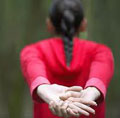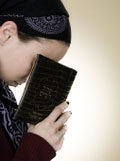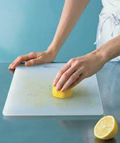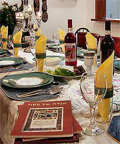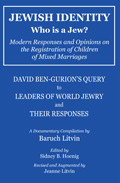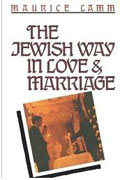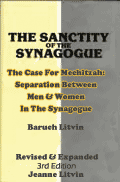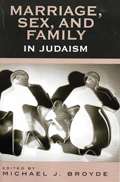FAMILY PURITY
For Married Women

Taharas HaMishpacha
♦♦♦♦♦
Immersing in the mikvah take a woman from a state of impurity (tumah)
to a state of purity (taharah)
- The terms Impurity (tumah) & purity (taharah), have nothing to do with being clean or dirty
- These terms relate to immersion of the soul
- Impurity (tumah) refers to a woman's status commencing on the onset of the menstrual
period which, of course, occurs when a woman hasn't become pregnant in the past month - It signifies the absence of a new life in her
- Immersion in a mikvah restores her to a state of purity (taharah) as she approaches anew
the potential to bring a new life into the world
When a woman sees
even a drop of blood discharged from her uterus,
she is considered a nidah
- A Nidah is a woman during her actual period of menstruation or a woman who may have
completed her menstrual period but has not yet immersed om a mikvah (ritual bath) - All physical contact between husband & wife is prohibited while the wife is a Nidah
- The status of Nidah during menstruation lasts a minimum of five days
- If the onset of menstruation occurs even a moment before sunset (shkiah) it is still considered the first of the five days
On the 5th day or the day your flow ends after the 5th day
- It is preferable to wash your whole body but if you can't do that at least wash the lower region (weekdays - not on Shabbas)
- Close to sunset (shkiah) (preferably 18 minutes before sunset), wrap a (checking) bedikah
cloth - a white, cotton, pre-washed examination cloth - around your finger - Check that your hands are clean
- Check that the cloth is clean on both sides before inserting the cloth
- An easier way to inserting the (checking) bedikah cloth is to stand with 1 foot elevated on a
chair or toilet seat cover - Insert the cloth into your vagina as deeply as possible & thoroughly wipe the entire accessible area, including all uneven surfaces, crevices & folds & then remove the cloth
- The discharge on the cloth should be clear
Additional checking (Bedika)
- (Hefsek Taharah)
A. If there are any spots or traces of red, black, brown or yellow, you may repeat the exam
the next day
B. You may do the exam each day until the cloth is clear of spots.
- (Moch Dachuk) insert another exam cloth (moch dachuk) before sunset (shkiah) & leave
it in until nightfall
A. This cloth should be checked for spots immediately upon removal
B. Place the cloth on a clean, non-plastic wrapper or envelope
C. Check it again by daylight the next morning
D. If both the hefsek tahara & the moch dachuk are successful, you can begin counting
your 7 preparatory days from the morning following the hefsek tahara
7 consecutive prep days
before you go to the Mikvah
The 7 prep days begin the 1st day following a successful hefsek tahara
- On each of the 7 days you make two checking (bedikos)
1. When you get up in the morning after sunrise
2. Before sunset (shkiah) - Wear white undergarments & use white bed sheets beginning immediately following the
hefsek tahara for the 7 prep days - Check the undergarments & sheets once daily for spots
- If you have difficulty making a bedikah, a Rabbi must be consulted to determine whether
fewer than the required number of bedikot may be made - If you inadvertently missed1or more of the bedikot, you may immerse in the mikvah at
the appropriate time as long as you made a successful hefsek tahara & at least 1 bedikah
on the 1st day & 1 on the last of the 7 preparatory days - Mark the date, 1 week from the day after your successful hefsek tahara, as the day to go
to the mikvah, if everything goes as planned - Bedikos during the 7 preparatory days must be done between sunrise & sunset
- Bedikos done after sunset have no validity
- If you experience spotting, staining or a renewed flow during your 7 preparatory days,
consult a qualified Rabbi on how to proceed - At nightfall after the seventh day, go to the mikvah
♦♦♦♦♦
DISTANCING PRACTICES DURING NIDAH
WHEN A COUPLE EATS TOGETHER
- They don't eat or drink from the same plate or cup
- They agree on a private signal that reminds them of the nidah status
SHOWING AFFECTION
- Many interactions between married couples have inherent romantic overtones
that can
lead to desire for intimacy - So the Jewish laws (Halacha) specifies certain activities that need to be modified or avoided during nidah
- A couple may not touch each other during the time the wife is nidah
1.No kissing or hugging or any other touching should take place
2.Torah law prohibits intercourse while a woman is nidah - A woman who is nidah should dress modestly in her husband’s presence, since he’s not
permitted to look at the parts of her body that are generally covered - A husband can look at his wife's face or other areas that are normally exposed
- Some women wear a certain piece of jewelry to remind her husband that she is a nidah
- A woman shouldn't try to be enticing
- Women should continue to dress nicely, in order not to become unattractive to her husband
BEDS
- When the wife is nidah, the couple may not sleep on the same bed - even if they are
clothed, use different blankets & don't touch - Most couples have 2 beds which can be brought together when relations are permitted & separated when they are not
- Some couples who want to share the same large bed when relations are permitted keep a
trundle or sleep couch alongside the main bed for use when the wife is a nidah - The husband may not sit on his wife's bed in her presence while she is nidah
- The husband may sit on her bed when she's not in the room, but may not lie down there
(some authorities say the husband may not sit on her bed at all) - The wife may sit on her husband's bed if he is in the room, but she may not lie down
- If the husband is not in the room, she may sit or lie on his bed
♦♦♦♦♦
Asking an Orthodox Rabbi for help
- The laws of Family Sanctity (Taharas HaMishpacha) are sacred & complex
- If you're not sure of what to do, don't try to decide on your own
- Your rabbi is available to help you
- If you are shy, the rabbi's wife or a mikvah attendant may ask the rabbi for you
♦♦♦♦♦
Visit: Mikvah
♦♦♦♦♦
Copyright © 2012 - 2017 KosherWoman.com
All rights reserved









